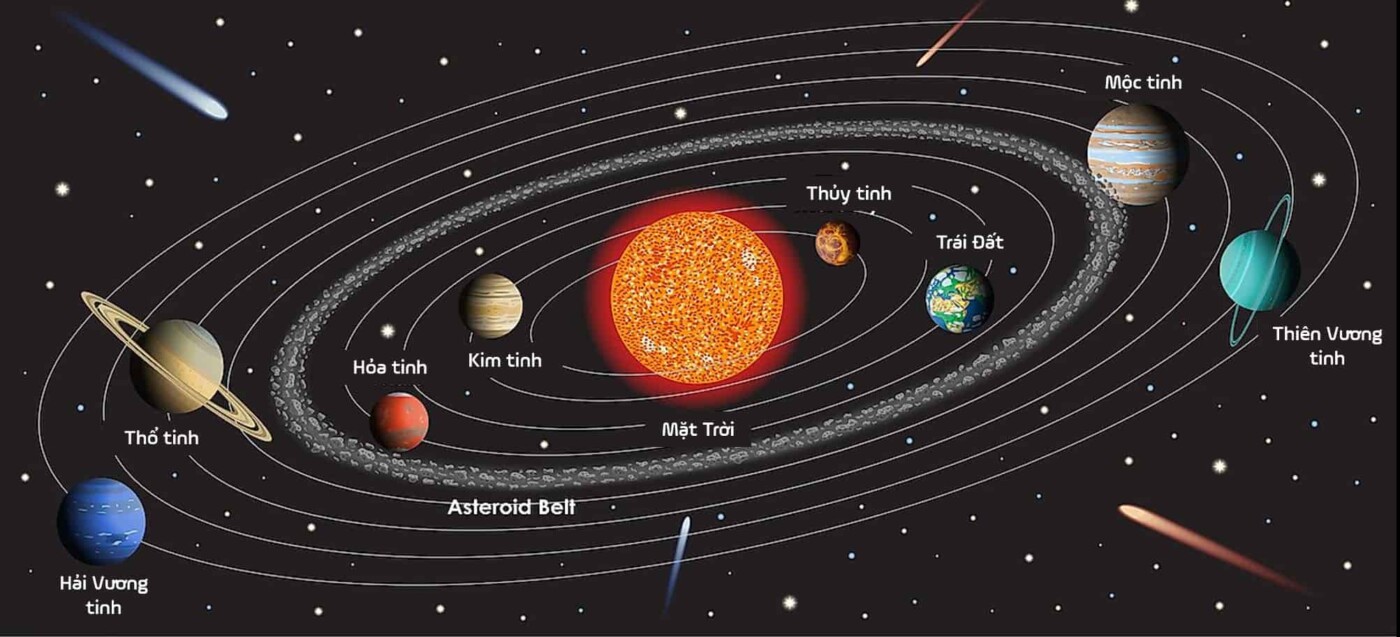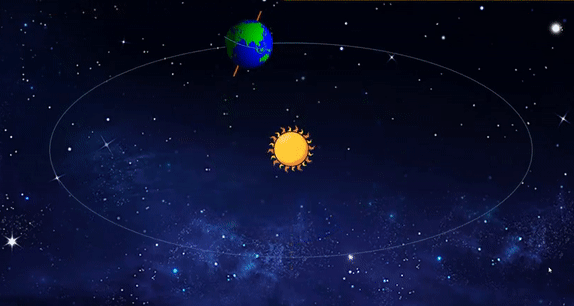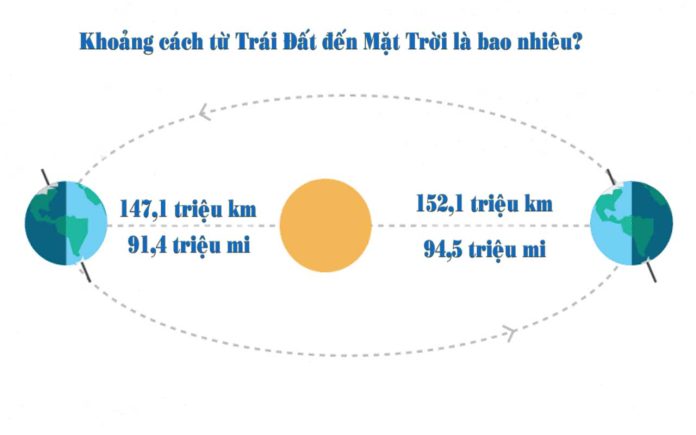The Sun is an endless source of energy for Earth and other planets in the solar system. Earth is the only planet with life in the universe. These two celestial bodies have a special relationship, not too close to get burned, not too far to freeze.
So do you know how many kilometers the Sun is from Earth? Does this gap change over time? How does this distance affect life on Earth? Let's learn about the distance and relationship between the two most important celestial bodies in our solar system in this article.

What is the distance from Earth to the Sun?
The distance from the Earth to the Sun is a quantity that is not fixed, but depends on the position of the Earth in its orbit around the Sun. The Earth has an elliptical orbit, meaning it is sometimes closer to the Sun and sometimes farther from the Sun. The average distance from the Earth to the Sun is called the astronomical distance (also known in astronomical units), equal to about 149.6 million km (exactly 149,597,870,700 meters). Usually people round it to 150 million km.
However, this distance can range from 147.1 million km when the Earth is at its closest point to the Sun (called perigee) around January 3 every yeararrive 152.1 million km when the Earth is at its farthest point from the Sun (called the apogee) around July 4 every year. Therefore, the distance from the Earth to the Sun is not a fixed number, but a number that varies with time and the Earth's position.

If you want to calculate the distance from the Earth to the Sun in light years, you can convert km to light years.
We need to know the speed of light in space, which is about 300,000 km/s. Therefore, we can calculate:
1 light year = 300,000 km/sx 60 sx 60 minutes x 24 hours x 365 days = 9.46 x 10^12 km
Distance from Earth to the Sun (in light years) = 149.6 x 10^6 km / 9.46 x 10^12 km = 0.00001581 light years. So, the distance from Earth to the Sun is about 0.00001581 light years, which is very small compared to the distance between other celestial bodies in the universe.
Based on that, we can easily calculate the distance from the Earth to the Sun in units such as Km or light years according to the data table below.
| Unit | Distance from Earth to the Sun |
|---|---|
| km | 149,597,870,700 Km |
| Light year | 0.00001581 light years |
| Minutes of light | 8 minutes 20 seconds of light |
| Seconds of light | 500 light seconds |
Thus, quite interesting information is that sunlight will take about 8 minutes and 20 seconds (or 500 seconds) to reach the earth.
Perigee and aphelion are two concepts in astronomy, related to the distance between a celestial body moving around another celestial body in an elliptical orbit. The perigee point is the closest point, and the apogee point is the furthest point. The distance from perihelion to perihelion affects the speed, temperature and light of the celestial body.
How does the distance from Earth to the Sun affect life on Earth?
The distance from the Earth to the Sun greatly affects life on Earth. If the distance is too close, the Earth will melt and burn. If the distance is too far, the Earth will freeze and freeze. Only a moderate distance, about 149.6 million km, can produce a stable climate, a day-night and seasonal cycle, a sufficient gravitational pull, and a sufficient amount of radiation to sustain sustain life on Earth.
The distance from the Earth to the Sun is not fixed, but changes according to the Earth's elliptical orbit around the Sun. When the Earth is at its closest point to the Sun (perigee), the distance is about 147.1 million km. When the Earth is at its farthest point from the Sun (apogee), the distance is about 152.1 million km. This change affects temperature, light, tidal fluctuations and other astronomical phenomena on Earth.
In addition, as we know, the Moon also orbits the Earth, so it also affects the tides and many other astronomical phenomena of the Earth. With the naked eye, we can easily recognize the Moon in the sky, and it has an important impact on life on Earth. But, what is the exact distance between the Earth and the Moon?
Because the Moon's orbit around the Earth is also oval shaped, the distance from the Earth to the Moon is not a fixed quantity, but depends on the Moon's position in its orbit around the Earth. Earth.
In fact, according to NASA, the average distance from Earth to the Moon is about 384,400 km. However, this distance can range from about 363,300 km when the Moon is at its closest point to the Earth (called perigee) to about 405,500 km when the Moon is at its furthest point from Earth (called aphelion). point). The Moon needs an average of 27.3 days to rotate once around the Earth (also known as the Moon's rotation period around the Earth is 27.3 days).
Distance from the sun to other planets in the solar system
The Solar System is a planetary system consisting of the Sun in the center and surrounding objects. The Solar System was formed from the collapse of a giant molecular cloud nearly 4.6 billion years ago.
Planets in the Solar System are large spherical bodies, orbiting the Sun in a determined orbit. There are eight recognized planets in the Solar System, in order from nearest to farthest from the Sun: Mercury, Venus, Earth, Mars, Jupiter, Saturn, Uranus and Neptune Vuong.
Rocky planets have nearly circular orbits and orbital planes that closely coincide with each other, called the ecliptic plane. The outer gas giants are much more massive than the inner rocky planets.
Planets can be classified into two main groups: terrestrial planets and gas giants. Terrestrial planets are planets that are small in size, composed mainly of rock and metal, and have no or few natural satellites.
The terrestrial planets include: Mercury, Venus, Earth and Mars. Gas giants are planets that are large in size, composed mainly of gas, mainly helium and hydrogen, and have many natural satellites. The gas giants include: Jupiter, Saturn, Uranus and Neptune.
Each planet has unique characteristics, such as size, mass, distance from the Sun, orbital period, rotation period, temperature, pressure, atmosphere, terrain, satellites, rings and astronomical phenomena.
Some more information about the average distance from the Sun to the planets in the Solar System, in order from near to far:
| Planet | Average distance (AU) | Average distance (km) |
|---|---|---|
| Glass | 0.387 | 57.91 million km |
| Lucifer | 0.723 | 108.2 million km |
| Earth | 1 | 149.6 million km |
| Mars | 1,524 | 227.9 million km |
| Jupiter | 5,203 | 778.5 million km |
| Saturn | 9,546 | 1.433 billion km |
| Heavenly King | 19,228 | 2.871 billion km |
| Neptune | 30,069 | 4.452 billion km |


